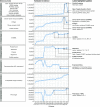Open Targets Platform: supporting systematic drug-target identification and prioritisation
- PMID: 33196847
- PMCID: PMC7779013
- DOI: 10.1093/nar/gkaa1027
Open Targets Platform: supporting systematic drug-target identification and prioritisation
Abstract
The Open Targets Platform (https://www.targetvalidation.org/) provides users with a queryable knowledgebase and user interface to aid systematic target identification and prioritisation for drug discovery based upon underlying evidence. It is publicly available and the underlying code is open source. Since our last update two years ago, we have had 10 releases to maintain and continuously improve evidence for target-disease relationships from 20 different data sources. In addition, we have integrated new evidence from key datasets, including prioritised targets identified from genome-wide CRISPR knockout screens in 300 cancer models (Project Score), and GWAS/UK BioBank statistical genetic analysis evidence from the Open Targets Genetics Portal. We have evolved our evidence scoring framework to improve target identification. To aid the prioritisation of targets and inform on the potential impact of modulating a given target, we have added evaluation of post-marketing adverse drug reactions and new curated information on target tractability and safety. We have also developed the user interface and backend technologies to improve performance and usability. In this article, we describe the latest enhancements to the Platform, to address the fundamental challenge that developing effective and safe drugs is difficult and expensive.
© The Author(s) 2020. Published by Oxford University Press on behalf of Nucleic Acids Research.
Figures




References
-
- Dimasi J.A., Grabowski H.G., Hansen R.W.. Innovation in the pharmaceutical industry: new estimates of R&D costs. J. Health Econ. 2016; 47:20–33. - PubMed
-
- Hay M., Thomas D.W., Craighead J.L., Economides C., Rosenthal J.. Clinical development success rates for investigational drugs. Nat. Biotechnol. 2014; 32:40–51. - PubMed
Publication types
MeSH terms
Substances
LinkOut - more resources
Full Text Sources
Medical
Molecular Biology Databases

